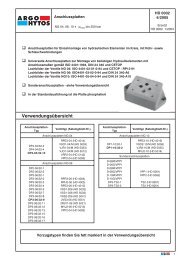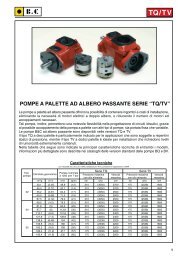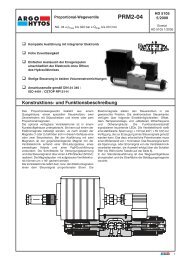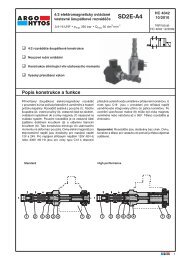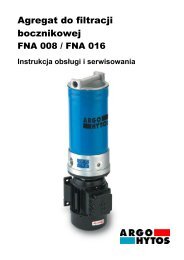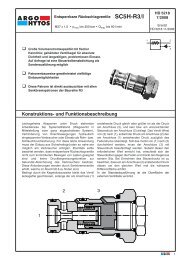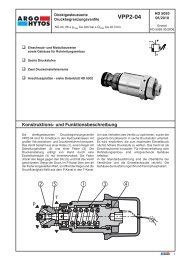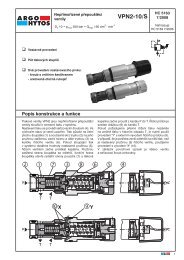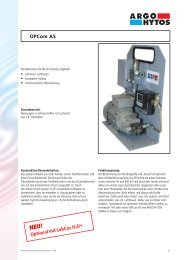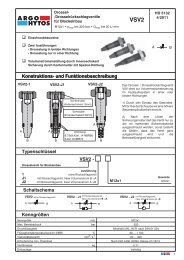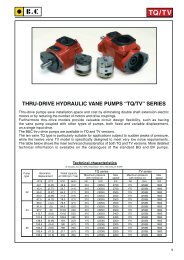E 328 ·E 498 ·Tank top mounting - Argo-Hytos
E 328 ·E 498 ·Tank top mounting - Argo-Hytos
E 328 ·E 498 ·Tank top mounting - Argo-Hytos
You also want an ePaper? Increase the reach of your titles
YUMPU automatically turns print PDFs into web optimized ePapers that Google loves.
R e t u r n - S u c t i o n F i l t e rs<br />
E <strong>328</strong> · E <strong>498</strong><br />
· Tank <strong>top</strong> <strong>mounting</strong><br />
· Connection up to -24 SAE and SAE 2<br />
· Nominal flow rate up to 158.5 gpm<br />
20.95-3us
112<br />
B<br />
D e s c r i p t i o n<br />
Application<br />
For operation in units with hydrostatic drives, when the return flow is higher<br />
than the oil flow of the boost pump under all operating conditions.<br />
Performance features<br />
Protection<br />
against wear: By means of filter elements that, in fullflow<br />
filtration, meet even the highest demands<br />
regarding cleanliness classes.<br />
Suction filter<br />
function: Because of the 100%-filtration of the suction flow,<br />
no dirt can get into the boost pump.<br />
Return filter<br />
function: By means of full-flow filtration in the system<br />
return, the pumps above all are protected from<br />
dirt particles remaining in the system after<br />
assembly, repairs, or which are generated by wear<br />
or enter the system from outside.<br />
Functional characteristics<br />
The hydraulic oil returning from the circuit (A) passes the filter element (1),<br />
is pressurized by a 7.3 psi check valve (2) and supplied to the boost pump<br />
(B). The surplus oil flows filtered over the integral check valve into the<br />
reservoir.<br />
As the boost pump is always fed with pressurized oil the risk of cavitation<br />
is minimized and full performance is available even during the critical cold<br />
start phase.<br />
An integral pressure relief valve (3) prevents high back pressure and<br />
protects the shaft seals against damages. As this valve leads the oil directly<br />
into the tank there is no direct connection between the return line (A) and<br />
the connection of the boost pump (B) (no bypass valve function).<br />
Function (schematic):<br />
3<br />
A<br />
1<br />
2<br />
The emergency-suction valve (4) with 300 µm protection strainer (5)<br />
supplies the boost pump in case of a short term of lack of oil.<br />
During normal operation, a lack of oil must not occur<br />
(refer to „Design“ section).<br />
Emergency-suction (schematic):<br />
B<br />
3<br />
4<br />
Start up / Deaeration<br />
For units with emergency-suction valve and protection strainer the start up<br />
set E <strong>328</strong>.1700 can be used to de-aerate the hydraulic system at first start<br />
up or at start up after repair; hereby the immediate supply of the boost<br />
pump with hydraulic oil is guaranteed.<br />
For all other types, deaerating instructions published by the manufacturers<br />
of hydraulic drives must be observed.<br />
Filter maintenance<br />
By using a clogging indicator the correct moment for maintenance is<br />
indicated and therefore guarantees the optimum utilization of the filter<br />
elements.<br />
Filter elements<br />
Flow direction from center to the outside. The star-shaped pleating of the<br />
filter material results in:<br />
• large filter surfaces<br />
• low pressure drop<br />
• high dirt-holding capacities<br />
• long service life<br />
Dirt deposits are entirely removed when the element is changed and<br />
cannot re-enter the tank.<br />
Accessories<br />
Electrical and optical clogging indicators are available.<br />
Dimensions and technical data see catalog sheet 60.20.<br />
A<br />
5
L a y o u t<br />
General<br />
In machines with a hydrostatic drive and combined working hydraulic<br />
system, suction-return filters replace the suction or pressure filters previously<br />
required for the feed pump of the closed-loop hydrostatic drive circuit as<br />
well as the return filter for the open-loop working hydraulic circuit.<br />
While each circuit operates independently with separate filters, the combination<br />
of the two circuits via the suction-return filter causes interaction<br />
between the circuits. If the design criteria described below are taken<br />
into account, you can take full advantage of the benefits provided by the<br />
suction-return filter concept, thus making sure that your system performs<br />
reliably even under extreme operat-ing conditions.<br />
Required return flow in the system<br />
In order to maintain a precharging pressure of approx. 7.3 psi at the intake<br />
of the feed pump, the return flow<br />
must exceed the suction flow under any operating conditions:<br />
• Versions with hole (Ø 0.32 inch) in the pressurizing valve:<br />
at least 7.9 gpm of excess flow<br />
Permitted feed pump flow rate<br />
• at operating temperature (ν < 280 SUS, rpm = max):<br />
feed pump flow rate < 0.5 x rated return flow according<br />
to column 2 of selection table<br />
• at cold start-up (ν < 4635 SUS, rpm=1000 min -1 ):<br />
feed pump flow rate < 0.2 x rated return flow according<br />
to column 2 of selection table<br />
Please contact us if your system operates with higher flow rates than<br />
stated above.<br />
Flow velocity in the connecting lines<br />
• Flow velocity in the return lines ≤ 14.8 ft/s<br />
• Flow velocity in the suction lines ≤ 4.9 ft/s<br />
Permitted pressure in the suction lines<br />
At cold start up (ν < 4635 SUS, rpm = 1000 min -1 ):<br />
feed pump flow rate ≤ 0.2 x rated return flow. The pressure loss in the<br />
suction lines must not exceed 5.8 psi.<br />
Backpressures in system return lines<br />
If drain oil from the hydrostatic drive is routed across the filter in addition<br />
to the flow of the open-loop circuit, the following has to be observed in<br />
order to protect the shaft seals:<br />
• permitted leakage oil pressure for a given viscosity and speed<br />
(manufacturer’s specifications!)<br />
• pressure loss caused by the leakage oil pipes<br />
• pressure loss caused by the oil cooler used<br />
• backpressure of the filter for a given flow rate or kinematic viscosity<br />
(refer to pressure loss diagrams)<br />
Depending on the application, the use of a cooler bypass valve is recommended.<br />
Generously sized drain oil pipes are also of advantage.<br />
Filter fineness grades<br />
With the filter fineness grades available, the following oil cleanliness<br />
according to ISO 4406 can be achieved:<br />
• 12 E-X: 18/15/12 ... 15/12/8<br />
• 16 E-X: 20/17/12 ... 17/14/10<br />
Even with the 16 E-X filter fineness grade, the requirements<br />
specified by manufacturers of hydrostatic drives are sometimes significantly<br />
exceeded .<br />
If components requiring a better oil purity are used, we recommend the 12<br />
E-X filter fineness grade.<br />
Suggested circuit layouts<br />
A) The leakage oil of the hydrostatic drive is routed across the filter.<br />
Drain oil<br />
to filter<br />
The entire dirt produced in the hydrostatic drive by abrasion is filtered out<br />
immediately and is thus not taken in by the pump of the open-loop circuit.<br />
This circuit layout is always recommended if the return flow only slightly<br />
exceeds the suction flow, i.e. if there is<br />
a risk that the 7.3 psi precharging pressure cannot be maintained.<br />
B) The drain oil of the hydrostatic drive is not routed across the filter but is<br />
discharged directly into the tank.<br />
Drain oil<br />
to tank<br />
Working hydraulics<br />
B<br />
Working hydraulics<br />
This circuit layout has the advantage that drain oil pressures are<br />
comparatively low.<br />
B<br />
A<br />
A<br />
P 1<br />
P 1<br />
113
114<br />
C h a ra c t e r i s t i c s<br />
Nominal flow rate<br />
Up to 158.5 gpm in return line (see Selection Chart, column 2)<br />
Up to 79.3 gpm feed pump flow rate (see Layout)<br />
The nominal flow rates indicated by ARGO-HYTOS are based on the<br />
following features:<br />
• closed by-pass valve at ν ≤ 930 SUS<br />
• element service life > 1000 operating hours at an average fluid<br />
contamination of 0.27 g per gpm flow volume<br />
• flow velocity in the return lines ≤ 14.8 ft/s<br />
• flow velocity in the suction lines ≤ 4.9 ft/s<br />
Connection<br />
Threaded ports according to SAE standard J514 and SAE flange (3000 psi).<br />
Sizes see Selection Chart, column 6 (other port threads on request)<br />
Filter fineness<br />
12 µm(c), 16 µm(c)<br />
β-values according to ISO 16889<br />
(see Selection Chart, column 4 and diagram Dx)<br />
Dirt-holding capacity<br />
Values in g test dust ISO MTD according to ISO 16889<br />
(see Selection Chart, column 5)<br />
Hydraulic fluids<br />
Mineral oil and biodegradable fluids<br />
(HEES or HETG, see info sheet 00.20)<br />
Temperature range<br />
- 22 °F ... + 212 °F (temporary - 40 °F ... + 248 °F)<br />
Viscosity at nominal flow rate<br />
• at operating temperature: ν < 280 SUS<br />
• as starting viscosity: ν max = 5560 SUS<br />
• at initial operation: The recommended starting viscosity can be<br />
read from the diagram D (pressure drop as<br />
a function of the kinematic viscosity) as<br />
follows: Find the 70% ∆p of the cracking<br />
pressure of the by-pass valve on the vertical<br />
axis. Draw a horizontal line so that it inter-<br />
sects the ∆p curve at a point. Read this point<br />
on the horizontal axis for the viscosity.<br />
Operating pressure<br />
Max. 145 psi<br />
Materials<br />
Screw-on cap: Aluminium alloy<br />
Filter head: Aluminium alloy<br />
Filter bowl: Steel<br />
Seals: NBR (Viton on request)<br />
Filter media: EXAPOR ® MAX - inorganic multi-layer microfibre web<br />
Fitting position<br />
Up to 15° from the vertical, preferably vertical<br />
Even under unfavorable operating conditions (min. oil level, max. sloping)<br />
the oil outlet resp. emergency suction has to be below the oil level.
D1<br />
D2<br />
Dx<br />
D i a g ra m s<br />
∆p-curves for complete filters in Selection Chart, column 3<br />
∆p [psi]<br />
∆p [psi]<br />
Q [gpm]<br />
Filter fineness curves in Selection Chart, column 4<br />
Filtration ratio β for particles > x µm<br />
Pressure drop as a function of the flow volume<br />
at ν = 162 SUS (0=casing empty)<br />
Pressure drop as a function of the flow volume<br />
at ν = 162 SUS (0=casing empty)<br />
Filtration ratio β as a function of particle size x obtained by the<br />
Multi-Pass-Test according to ISO 16889<br />
Particle size x [µm] (for particles larger<br />
than the given particle size x)<br />
Pressure drop as a function of the kinematic viscosity<br />
at nominal flow<br />
∆p [psi]<br />
∆p [psi]<br />
ν [SUS]<br />
Pressure drop as a function of the kinematic viscosity<br />
at nominal flow<br />
Q [gpm] ν [SUS]<br />
Efficiency [%]<br />
The abbreviations represent the following β-values resp.<br />
finenesses:<br />
For EXAPOR ® MAX- and Paper elements:<br />
5 E-X = β 5 (c) = 200 EXAPOR ® MAX<br />
8 E-X = β 8 (c) = 200 EXAPOR ® MAX<br />
12 E-X = β 12 (c) = 200 EXAPOR ® MAX<br />
16 E-X = β 16 (c) = 200 EXAPOR ® MAX<br />
30 P = β 30 (c) = 200 Paper<br />
Based on the structure of the filter media of the 30 P paper<br />
elements, deviations from the printed curves are quite propable.<br />
For special applications, finenesses differing from these curves<br />
are also available by using special composed filter material.<br />
115
116<br />
S e l e c t i o n C h a r t<br />
Part No.<br />
Nominal return flow<br />
Pressure drop see<br />
diagram D/curve no.<br />
Filter fineness see Diagr. DX<br />
Dirt-holding capacity<br />
Connections A/B<br />
SAE (3000 psi)<br />
Cracking pressure of PRV<br />
Symbol<br />
2<br />
Cracking pressure of CV1 gpm g SAE psi psi<br />
lbs<br />
Replacement filter element<br />
Part No.<br />
Weight<br />
1 2 3 4 5 6 7 8 9 10 11 12<br />
E <strong>328</strong>-756 79.3 D1/1 12 E-X 110 -24 3 / SAE 2 + -16 4 7.3 36 1 V5.1240-06 19.0 5 + 6<br />
E <strong>328</strong>-758 118.9 D1/2 16 E-X 110 -24 3 / SAE 2 + -16 4 7.3 36 1 V5.1240-07 19.0 5 + 6<br />
E <strong>498</strong>-756 118.9 D2/1 12 E-X 160 -24 3 / SAE 2 + -16 4 7.3 36 1 V5.1260-06 22.9 5 + 6<br />
E <strong>498</strong>-758 158.5 D2/2 16 E-X 180 -24 3 / SAE 2 + -16 4 7.3 36 1 V5.1260-07 22.9 5 + 6<br />
All filters are delivered with plugged clogging indicator connections M 12 x 1.5 (Mounting holes for differential pressure switches on request).<br />
Either manometers or electrical pressure switches can be used as clogging indicators on the return side (P 1 ).<br />
Monitoring of the vacuum on the suction side (P 2 ) is additionally possible.<br />
Order example: The filter E <strong>328</strong>-756 has to be supplied with 2 x 4 connections (A 1 ... A 4 , B 1 ... B 4, ).<br />
Order description: E <strong>328</strong>- 856<br />
Connections:<br />
2 various options are available:<br />
2 x 2 connections (A and A 4 , B and B 4 ) - -24 SAE / SAE 2, -16 SAE (plugged with locking screw) 7<br />
2 x 4 connections (A 1 ... A 4 , B 1 ... B 4 ) - 2 x -20 SAE / SAE 1½, -12 SAE + -16 SAE 8<br />
(SAE 2 on request)<br />
For the appropriate clogging indicator see catalog sheet 60.20.<br />
Remarks:<br />
• The start of the red area and the switching pressure of the electrical pressure switch always has to be lower than the cracking pressure of the<br />
pressure relief valve (see Selection Chart, column 9).<br />
• The clogging indicators are optional and always delivered detached from the filter.<br />
• The filters listed in this chart are standard filters. If modifications are required, we kindly ask for your request.<br />
• For deaeration a start up set is available with Part-No. E <strong>328</strong>.1700, technical details see catalogue sheet 20.890.<br />
1 Cracking pressure of check valve 3 corresponds to 1 7 /18 -12 UN 5 with hole Ø 0.32 inch in the check valve for oil drain when opening the filter cover<br />
2 Cracking pressure of pressure relief valve 4 corresponds to 1 5 /16 -12 UN 6 with emergency-suction valve and protection strainer (300 µm)<br />
Remarks
D i m e n s i o n s<br />
Version with 2 x 4 connections Version with 2 x 2 connections<br />
M e a s u re m e n t s<br />
1 2<br />
X<br />
2 3<br />
2<br />
3<br />
Connections M12 x 1.5<br />
for clogging indicator<br />
standard<br />
(Mounting holes for<br />
differential pressure<br />
switches on request<br />
Suitable SAE -<br />
flange on request<br />
ARGO-HYTOS Part-No.<br />
reference N036.0501<br />
*<br />
Type A B C D E F F 1 2<br />
Z<br />
Connections -16 SAE<br />
plugged with locking screw<br />
Dia hole in<br />
reservoir<br />
Port sizes and <strong>mounting</strong> face<br />
(O-ring area of support hatched)<br />
Tank surface sealing with<br />
O-ring N007.1375<br />
(included in basic equipment)<br />
* F F4 F G H H I I 3<br />
5 1 2 1 2<br />
E <strong>328</strong> s. Selection Chart s. Selection Chart 5.53 5.43 5.51 1.42 4.11 1.26 1.38 4.96 0.45 6.50 7.28 21.26 22.24<br />
E <strong>498</strong> s. Selection Chart s. Selection Chart 5.53 5.43 5.51 1.42 4.11 1.26 1.38 4.96 0.45 6.50 7.28 29.53 30.71<br />
Type K1 K2 L M N1 N2 O Q R S1 S2 T U V W X Y Z<br />
E <strong>328</strong> 16.73 15.87 7.28 3.41 4.57 3.50 M10 0.71 1 /2 -13 UNC 3.90 4.29 6.30 17 mm 4.13 4.02 2.76 3.86 0.47<br />
E <strong>498</strong> 24.80 23.82 7.28 3.41 4.57 3.50 M10 0.71 1 A/F<br />
/2 -13 UNC 3.90 4.29 6.30 17 mm 4.13 4.02 2.76 3.86 0.47<br />
*For use of SAE-flanges see this measurement<br />
S y m b o l s<br />
117
118<br />
3<br />
S p a re Pa r t s<br />
Q u a l i t y A s s u ra n c e<br />
Quality management according to DIN EN ISO 9001<br />
To ensure constant quality in production and operation,<br />
ARGO-HYTOS filter elements undergo strict controls and tests<br />
according to the following DIN and ISO standards:<br />
DIN ISO 2941 Verification of collapse/burst resistance<br />
DIN ISO 2943 Verification of material compatibility with fluids<br />
DIN ISO 3724 Verification of flow fatigue characteristics<br />
1<br />
2<br />
4<br />
Our engineers will be glad to assist you with questions concerning filter application, selection, and cleanliness class of the filtered medium attainable under<br />
practical operating conditions.<br />
Illustrations may sometimes differ from the original. ARGO-HYTOS is not responsible for any unintentional mistake in this specification sheet.<br />
Pos. Designation Part No.<br />
1 Cover E 443.1225<br />
2 O-ring 5.98 x 0.21 N 007.1525<br />
3 Filter element see Chart / col. 10<br />
4 O-ring 5.37 x 0.21 N 007.1375<br />
The functions of the complete filters, as well as the outstanding features<br />
of the filter elements assured by ARGO-HYTOS, can only be guaranteed if<br />
original ARGO-HYTOS spare parts are used.<br />
ISO 2942 Verification of fabrication integrity (Bubble Point Test)<br />
ISO 3968 Evaluation of pressure drop versus flow characteristics<br />
ISO 16889 Multi-Pass-Test (evaluation of filter fineness and<br />
dirt-holding capacity)<br />
Various quality controls during the production process guarantee the<br />
leakfree function and solidity of our filters.<br />
We produce fluid power solutions<br />
ARGO-HYTOS Inc. · P.O. Box 28 · Bowling Green, OH 43402 · USA<br />
Tel: +1-419-353-6070 · Fax: +1-419-354-3496 · info.us@argo-hytos.com · www.argo-hytos.com<br />
Subject to change<br />
9107293-us · 0206



